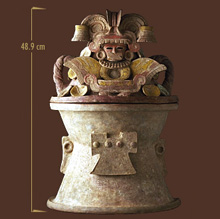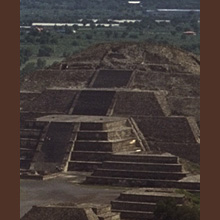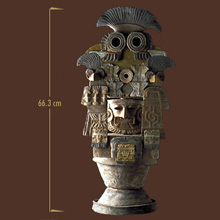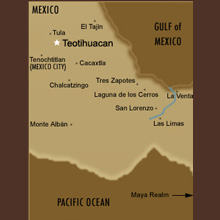let the objects speak
Teotihuacan - Incense Burner

By A.D. 450 mould-made ceramic incense burners such as this one were being mass-produced at Teotihuacan for local use as well as trade. The burners are rich in iconography, much of which appears in applied stamped symbolic images. The makers also gave much attention to the face, and emphasized the design modestly with coloured slip. This burner depicts the 'Butterfly God'. It was used in ceremonial settings, and its condition suggests that its final use was as a burial accompaniment. It was probably an important part of ceremonies at one of Teotihuacan's temples or palaces, or it may have been used in a household as a miniature shrine.

Who
A great trading community, Teotihuacan was the centre for distribution of valuable commodities such as obsidian, through a network controlled by complex religious and political systems. The city's massive ceremonial buildings, palaces and other dwellings, in many of which the remnants of brightly coloured murals remain, harmonize with the natural landscape. Covering approximately 21 square kilometres, Teotihuacan was the largest city in the world in its day, and served as a crossroads to the Pacific and Atlantic coasts, as well as southward to the Zapotec and Maya worlds.

What
Incense-burners were not only placed whole in graves as funerary offerings, but also were broken and scattered around the body of the deceased. It was common to set such censers within courtyards shared by adjoining households, and to use them for burning incense on communal staircases. Butterfly imagery, believed to be a symbol of fertility, is prominent on censers, and in addition, many butterfly-shaped plates have been found at Teotihuacan. The censer pictured left is adorned with four moulded butterflies above the recessed face in addition to a fifth butterfly to the left of the pot's visage.

Where
Nearly 2000 years of settlement in and around the Valley of Mexico gave rise to a prestigious and highly influential civilization at Teotihuacan by about A.D. 150. Initially a small settlement, it quickly grew into a city with a population of about 150,000. A very important economic and religious centre, it came under attack from northern peoples by about A.D. 600-650, fell into decline around a century later, and was eventually sacked and destroyed.

Long after it was abandoned, the great city remained a locale for worship, a vacated place of mystery to the civilizations that followed. Belief in Quetzalcoatl, the Feathered Serpent, was given its first major physical representation in motifs at Teotihuacan. For this and other reasons the city, though it lay in ruins, was an important feature in Toltec and Aztec mythology.